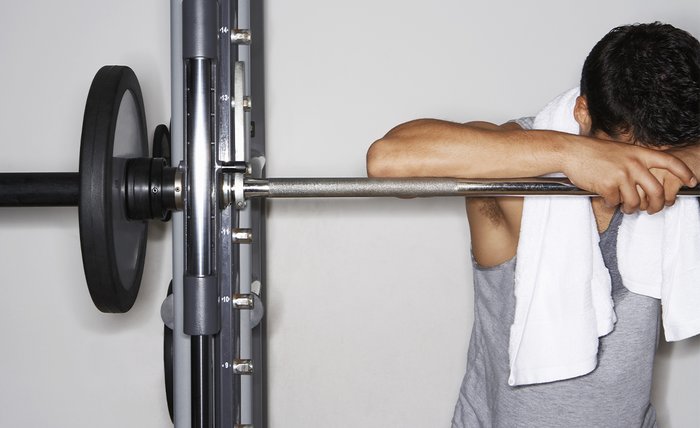Products You May Like
All training and fitness-related goals require self-discipline and the willingness to delay immediate gratification for the sake of bigger, more meaningful future payoffs. But unfortunately, these skills rarely come naturally. In fact, they are actually in direct opposition to your natural inclinations.
We are literally wired to be skinny-fat. Once you start training hard and eating better, adding muscle and dropping stored fat, your metabolic operating system becomes convinced that you’re starving—even though, just to be clear, you’re not. Sensing impending disaster, your homeostatic feedback mechanisms go DEFCON 5 in an effort to prolong your life. Two particularly powerful mechanisms include:
- Your unconscious activity levels—everything from walking and talking to fidgeting and blinking—get reduced. When you’d normally pace, you’ll just stand. When you’d normally stand, now you’ll sit. When you’d normally sit, now you’ll lie down. Bottom line: Any and all physical activities will require more motivation.
- Your stomach will increase ghrelin production for the purpose of increasing your appetite.
As you ponder these harsh realities, you begin to understand why so few ever get conspicuously muscular and lean. Not only are your family and friends not on board, your own body is fighting you every step!

Now on to the good news: There is a simple (not easy, mind you) three-step strategy that helps streamline the process and help you build lasting, transformative self-discipline. Here’s how to do it.
Step 1: Stack the Deck in Your Favor
Lots of people want to start the fitness conversation with talking about self-discipline, but for me, it’s definitely not step one. Instead, I like to start by trying to create an environment where every iota of self-discipline will have a better chance to succeed. This starts with facing what I call the “twin enemies” of self-discipline: stress and fatigue.
Why start here? Stress and fatigue work synergistically to erode your ability to work hard and delay immediate gratification, so anything you can do to reduce them—and/or increase your resiliency to them—should be considered a high priority. Let’s address them one at a time.
Stress
I learned the impact of stress (and the power of reducing it) by accident several years ago. I was experiencing financial stress, and it was taking a toll on my training and nutrition in addition to my overall quality of life.
One day, out of nowhere, I received a totally unexpected (and large) payment from a company I used to work for. That night, and over the following few weeks, it was like a fog lifted. And I experienced some of my best workouts ever.
So, the lesson is…find some unexpected money? No, not at all. It’s simply to realize that when your non-training life is completely out of whack, it drains your energy and eats away at your resolve.
Remember: Physical training is a stressor. And for that reason, I and many other coaches find that seriously intense works most effectively against the backdrop of a well-functioning life. If you have simmering lifestyle issues, they deserve the same level of attention and dedication as your diet or the size of your arms. These things are all part of the same project.

Does that mean that you shouldn’t train at all if your life is out of whack? Thankfully, no. One thing that’s great about straightforward full-body strength training like my BodyFit program Total-Body Strong is that it’s sustainable in terms of intensity and volume, and won’t dramatically add stress to the rest of your life.
That means you can keep punching the clock and doing the workouts three times a week in both the good and rough times, and be confident that it’s helping you move forward.
Fatigue
Fatigue is one of those tricky problems that comes from a number of sources, including high stress levels. But one nice thing about it is that it can pretty much always be improved—often dramatically—by improving your sleep and rest practices.
What’s known as “sleep hygiene” has been a hot topic for a while now, and there is no shortage of information on this subject. And while you’ll find a range of conflicting ideas about certain aspects of it, most experts agree on the following:
- Perform a “mind dump” prior to bedtime by creating a to-do list for the following day. As best-selling author David Allen likes to remind his readers “your brain is for having ideas, not storing them.”
- Establish a consistent sleep schedule and stick to it. Literally. Schedule your sleep just like you would with any other important event, and organize the day’s events in order to facilitate this schedule. If your sleep schedule is 11-7, maintain those hours every single day, rather than “sleeping in” on weekends or staying up later on a certain night just because you don’t feel really tired.
- Limit stimulatory experiences as bedtime nears, including work tasks, TV, computer and cell phone use, caffeine intake, stressful conversations, and so on. This helps you transition into your sleep schedule.
- Respect your bedroom! Keep electronics out of it, and keep it dark, cool, clean, and comfortable. Consider a weighted blanket or a water-cooled mattress.
- Experiment with small ways to help improve your sleep quality, not just quantity. Many people sleep better when they listen to white noise. Others thrive with earplugs. Everyone’s different, so stay open to new developments and don’t be afraid to experiment.
- Many bigger guys suffer (often unknowingly) from sleep apnea. Do a bit of research and if you have any suspicion you have this issue, ask your doctor to prescribe a sleep study.

Step 2: Optimize Your Fitness Environment
Even if your self-discipline is well-developed, you’re going to struggle mightily if the world is fighting your efforts every step of the way. And I’m not talking about the big-W world, but rather, your personal place in it. Start to proactively reduce or eliminate all sources of environmental friction including:
- Long commutes to the gym. Find a closer facility if possible, or stay open to any opportunity to develop your home gym.
- People who either don’t support, or even worse, activity oppose, your training goals. The word “haters” may be a bit intense, but “fitness cynics” definitely abound. Do your best to make your social circle aware of how important your goals are to you, and how they can be a better source of support. Failing that, consider limiting your exposure to those who you know are antagonistic to your efforts.
- Food that doesn’t support your goals. Keep your kitchen full of productive foods that you like, and devoid of items that you have a hard time resisting. Additionally, make sure your kitchen is well organized and equipped with the basics: spices, healthy cooking oils, and any essential accessories that streamline meeting your nutritional goals. These vary from person to person, but high-quality Tupperware, a blender, and a pressure cooker all come to mind.
There are innumerable examples of this strategy, so train yourself to notice environmental friction, and whenever you identify sources of it, take the necessary steps to remove the offending stressor.
Step 3: Create Daily Challenges and Small Victories
OK, now it’s time to talk discipline. Despite how people tend to brag—er, talk about it—discipline not a genetically-ingrained trait. It’s actually a habit, and one that you can, and should, develop and strengthen like any other.
Why focus on building it rather than just “trusting” the level of discipline you have? Because when steps 1, 2, and 3 fail, you still have a final barrier between yourself and failure.

Developing this skill isn’t “easy” (which should be intuitively obvious) but it is relatively simple—it’s simply a matter of proactively and systematically exposing yourself to gradually more difficult personal challenges.
Today (not tomorrow), make a point of doing something unpleasant or uncomfortable, just for its own sake. It doesn’t have to be much. It can be denying yourself a night of pointless TV, taking a cold shower, doing a workout rather than skipping one, making dinner rather than buying it, having an overdue conversation—the list is endless. After you’ve done it, note how difficult it was. Probably not as much as you feared.
But even if it was, there’s a sense of pride that inevitably wells up when you made the choice and did it. Even if you didn’t achieve victory over your challenge, you achieved a small victory over your lesser nature.
Tomorrow, use that inner pride as fuel as you repeat that process again…and again, and again. Just like your quads and pecs, self-discipline can be strengthened. In the same way that a 135-pound squat is heavy one day, but a warm-up a year later, things that strike you as difficult today will become painless and routine soon enough.
Do It Today!
The process I’ve described is reliably effective and virtually foolproof. Following the three steps I’ve outlined above will change your life for the better if you choose to get on the path of discipline. And if my program Total-Body Strong helps you build it, all the better.
Procrastination is the enemy of self-discipline, so initiate this change TODAY, even if you start very small. If you need additional help, I’ll be monitoring the comments section, so please post your questions, challenges, and victories below!
